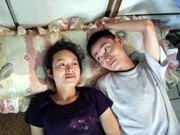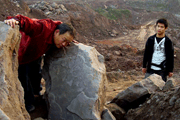 The Other Half, 2006. In its fractured, interpenetrating (or rather, colliding) realities, Ying Liang’s The Other Half foreshadows Jia Zhang-ke’s 24 City, capturing China’s transforming industrial landscape through its alienated and displaced humanity. The opening frontal shot of job seeker, Xiaofei being interviewed by an off-camera recruiter establishes a sense of division – the unseen economic, social, educational, and gendered “other half” – that resurfaces throughout the film. Having landed the job as clerk for a law office, Xiaofei is now, too, on the other side of the camera (the supplanted image of Xiaofei with the people, often women, seeking consultation suggesting their interchangeable status), listening to potential clients as they seek advice for their grievances, whether a way out of a loveless or abusive marriage (or the financial repercussions of divorcing a wealthy husband), revenge for an extramarital affair, work-related problems, or even just to have someone listen to them (in one episode, a woman takes advantage of the firm’s free consultation service to talk about her everyday struggles before a befuddled attorney).
The Other Half, 2006. In its fractured, interpenetrating (or rather, colliding) realities, Ying Liang’s The Other Half foreshadows Jia Zhang-ke’s 24 City, capturing China’s transforming industrial landscape through its alienated and displaced humanity. The opening frontal shot of job seeker, Xiaofei being interviewed by an off-camera recruiter establishes a sense of division – the unseen economic, social, educational, and gendered “other half” – that resurfaces throughout the film. Having landed the job as clerk for a law office, Xiaofei is now, too, on the other side of the camera (the supplanted image of Xiaofei with the people, often women, seeking consultation suggesting their interchangeable status), listening to potential clients as they seek advice for their grievances, whether a way out of a loveless or abusive marriage (or the financial repercussions of divorcing a wealthy husband), revenge for an extramarital affair, work-related problems, or even just to have someone listen to them (in one episode, a woman takes advantage of the firm’s free consultation service to talk about her everyday struggles before a befuddled attorney).
But Xiaofei’s notes also prove to be transcriptions of her own imperfect reality: living with an aimless, trouble-prone boyfriend, Deng Gang whose only motivation in life seem to be gambling and drinking with friends (even as he boasts of being rich and important someday), estranged from her father (Liu Huibin) who had left years earlier to find work in Xinjiang, and goaded by her well-intentioned mother (Chen Xigui) to use her good looks to find a more marriage prospect-worthy suitor. In this respect, the running joke on Xiaofei’s resemblance to actress Zhang Ziyi not only serves as comic relief, but also reinforces her role as a surrogate identity – the anonymous face of a marginalized working class and its idealization. This intersection between personal and professional, private and public spheres is also suggested in Xiaofei’s earlier disclosure that she had applied for the job opening based on the employment agency’s recommendation that is subsequently paralleled in her mother’s (Chen Xigui) matchmaking attempts to introduce her to a wealthy businessman (despite still being involved with Deng Gang) – both reflecting a position of disempowerment and acquiescence towards her own future. Similarly, the incisive juxtaposition of a benzene accident at a Zigong chemical factory (made ironic by earlier broadcasts of the industry’s commitment to environmental responsibility) against a kitchen fire in a neighborhood mahjong parlor also creates a sense of chaos and dislocation, illustrating the role of impersonal industries as manufacturers of artificial, uprooted communities – the residential evacuation of nearby districts as a result of windswept toxic fumes (leaving them to camp out in cramped tunnels, literally tripping over people in order to move ahead), that is contrasted against images of patrons hauling buckets of water to stamp out the blaze. Culminating with a long shot of Xiaofei’s friend circling in and out of view (in a shot that evokes the poetic bicycle sequence in Jia’s Unknown Pleasures) to offer her a ride home, the framing of a nearly indistinguishable Xiaofei against a vast, empty landscape becomes a paradoxical metaphor for erasure and persistence.
 Good Cats, 2008. Something like Jia Zhang-ke’s portraits of contemporary China by way of Hou Hsiao-hsien’s stationary long shots and sense of landscape, Good Cats returns to the hybrid fiction of Ying Liang’s previous film, The Other Half to capture the dislocation and moral vacuum left in the wake of China’s rapid economic development. Similar to The Other Half, Good Cats is also set in Ying’s hometown of Zigong, and like his earlier film, a frontal shot of the main character being questioned by an unseen interviewer also serves as the opening sequence (in this case, by a fortune teller looking to glean information for his palm reading), reflecting the interrogative nature of Ying’s gaze. However, inasmuch as Ying frames the estrangement in The Other Half from a native point of view, the sense of displacement in Good Cats is also a geographic one – embodied by underemployed 29 year old, Luo Liang who works as a driver for light bulb salesman turned real estate investor, Boss Peng (his provincial upbringing is suggested in an early episode in which his co-workers tease him for not being able to eat spicy Sichuan cuisine), and also the villagers protesting their eviction from a tract of land that Boss Peng has targeted for redevelopment (in a tacit agreement with corrupt village chief Zong). Living in a dilapidated, gas-leak prone apartment with his over-critical wife (who, along with her parents, hound him to go to night school in order to land a more prestigious and financially secure job), continuing to support his neighbor and former mentor, Liu Xiaopei who has fallen into hard times, and assisting with the murky dealings of his increasingly unstable employer, Luo Liang is a marginal bystander to the country’s alienating transformation – a figurative impotence that is reinforced in his extended family’s strong arm attempts to goad him into starting a family as a means of saving face within their ancestral community. Moreover, Luo Liang’s disconnection from his intrusive extended family also exposes a sense of rootlessness that reveal a broader cultural malaise – a despritualization that is suggested in the surreal shot of Luo Liang and Boss Peng impounding the disarticulated head of a Buddha statue into the back of a pickup truck as collateral for an overdue loan (in an absurdist convergence of spirituality and economics that recalls the failed crucifix venture of Roy Andersson’s Songs from the Second Floor). Framed in the context of Luo Liang staggering through a communal farm, his instinctual quest to return home becomes a potent image of marginalized struggle and uprooted ideology.
Good Cats, 2008. Something like Jia Zhang-ke’s portraits of contemporary China by way of Hou Hsiao-hsien’s stationary long shots and sense of landscape, Good Cats returns to the hybrid fiction of Ying Liang’s previous film, The Other Half to capture the dislocation and moral vacuum left in the wake of China’s rapid economic development. Similar to The Other Half, Good Cats is also set in Ying’s hometown of Zigong, and like his earlier film, a frontal shot of the main character being questioned by an unseen interviewer also serves as the opening sequence (in this case, by a fortune teller looking to glean information for his palm reading), reflecting the interrogative nature of Ying’s gaze. However, inasmuch as Ying frames the estrangement in The Other Half from a native point of view, the sense of displacement in Good Cats is also a geographic one – embodied by underemployed 29 year old, Luo Liang who works as a driver for light bulb salesman turned real estate investor, Boss Peng (his provincial upbringing is suggested in an early episode in which his co-workers tease him for not being able to eat spicy Sichuan cuisine), and also the villagers protesting their eviction from a tract of land that Boss Peng has targeted for redevelopment (in a tacit agreement with corrupt village chief Zong). Living in a dilapidated, gas-leak prone apartment with his over-critical wife (who, along with her parents, hound him to go to night school in order to land a more prestigious and financially secure job), continuing to support his neighbor and former mentor, Liu Xiaopei who has fallen into hard times, and assisting with the murky dealings of his increasingly unstable employer, Luo Liang is a marginal bystander to the country’s alienating transformation – a figurative impotence that is reinforced in his extended family’s strong arm attempts to goad him into starting a family as a means of saving face within their ancestral community. Moreover, Luo Liang’s disconnection from his intrusive extended family also exposes a sense of rootlessness that reveal a broader cultural malaise – a despritualization that is suggested in the surreal shot of Luo Liang and Boss Peng impounding the disarticulated head of a Buddha statue into the back of a pickup truck as collateral for an overdue loan (in an absurdist convergence of spirituality and economics that recalls the failed crucifix venture of Roy Andersson’s Songs from the Second Floor). Framed in the context of Luo Liang staggering through a communal farm, his instinctual quest to return home becomes a potent image of marginalized struggle and uprooted ideology.
Acquarello, 2009 [reprinted]